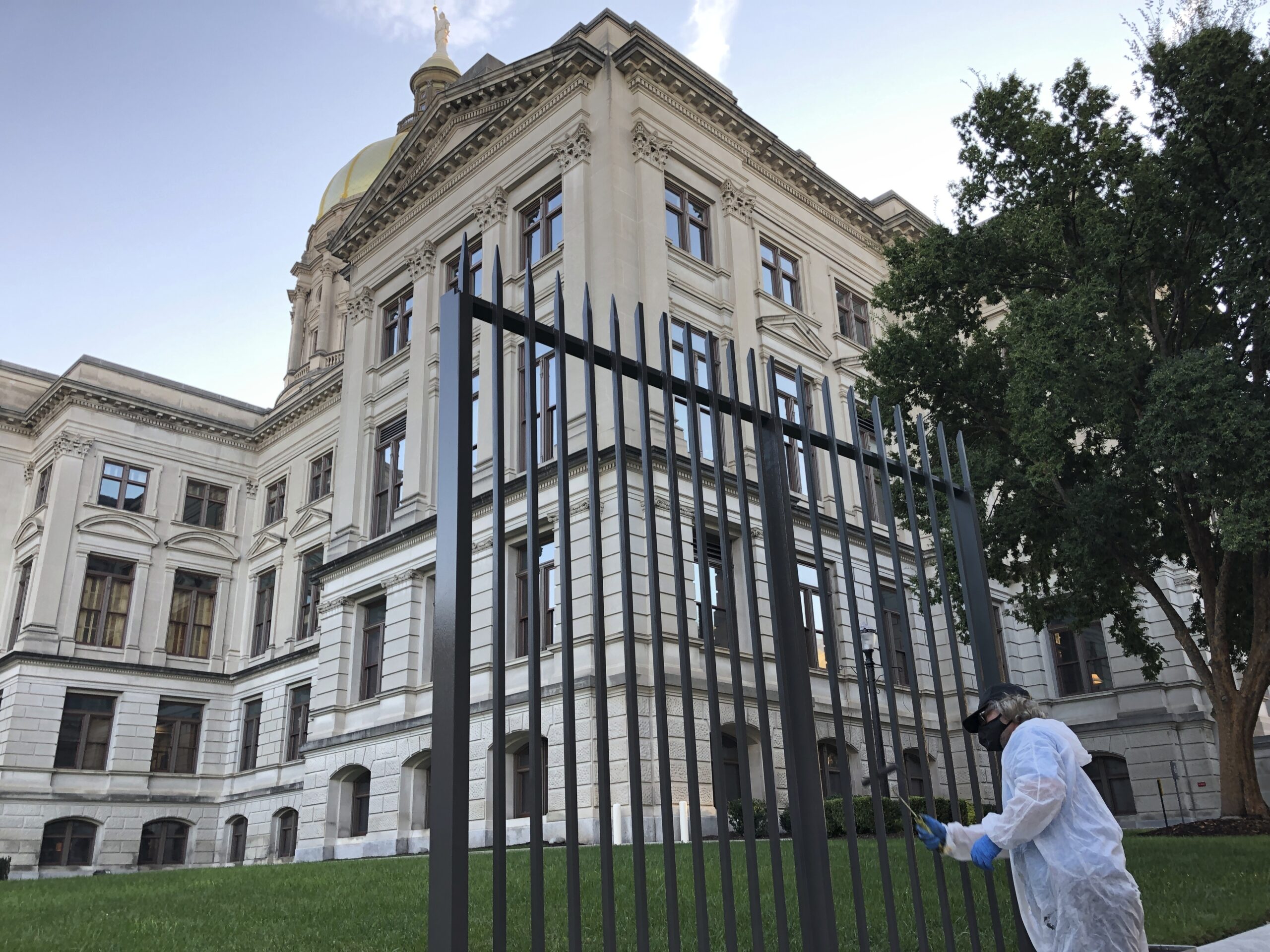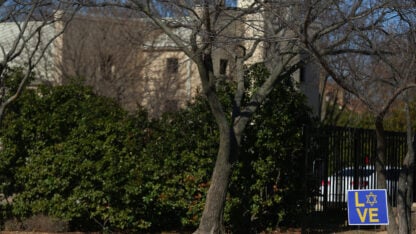After Protests, Georgia To Build Fence Around State Capitol

A Georgia Building Authority employee paints sample sections of a fence outside the Georgia state Capitol on Wednesday in Atlanta. Gov. Brian Kemp has approved a plan to spend $5 million to ring the block holding the Capitol with a fence and make other security improvements after months of periodic protests. The Republican governor says the fence is needed, but Democrats and those aligned with protesters say it shows a government afraid of its own people.
Jeff Amy / Associated Press
After months of periodic protests at Georgia’s state Capitol aimed at reforming police and removing Confederate statues, Gov. Brian Kemp has approved a plan to put up a tall metal fence around the building.
Democrats swiftly condemned the plan, saying it shows a Republican leadership afraid of its own people.
“To ensure the safety of state employees, protect the public and prevent damage to state property, the Department of Public Safety and the Georgia Building Authority recommended numerous improvements to a number of state buildings,” said Cody Hall, a spokesperson for Kemp. “The governor agreed with their assessment.”
The plan first reported by WSB-TV on Tuesday is part of a $5 million package that includes other security improvements at the Capitol, and officials say they’re discussing additional work beyond that, at a state office complex in a residential neighborhood southeast of the Capitol where protesters damaged the Department of Public Safety’s headquarters on July 4.
Security will also be strengthened at the governor’s mansion in Atlanta’s Buckhead neighborhood. Demonstrators have lined the street outside the mansion at times in recent months.
“I am against this fence. From the 40 State Patrol cars and dozens of officers brought in when we debate something controversial to this fence, it sure seems the Georgia GOP is terrified of the people of our state,” state Sen. Elena Parent, an Atlanta Democrat, wrote on Twitter. “I pity them that their worldview is so paranoid.”
A worker with the Georgia Building Authority on Wednesday was painting a demonstration section of the barrier outside the building. The metal bars are 8 feet tall with spikes on top.
The Georgia Building Authority’s board, including Kemp and Secretary of State Brad Raffensperger, also a Republican, approved the plan Monday.
Authority Chief of Staff Gerald Pilgrim said the state is negotiating with vendors for a price and hopes to complete work on the fence by spring 2021.
Preliminary work to relocate sprinklers and lights, making way for a concrete foundation, is already ongoing. People will still be able to come in through four to six gates, Pilgrim said, although renderings show those gates will be able to be closed.
“Can there be a more undemocratic symbol than gated government?” asked House Minority Leader Bob Trammell, a Luthersville Democrat. “Just the most recent example of Republicans erecting barriers to citizen participation in our government.”
House Speaker David Ralston, a Blue Ridge Republican, supports the move.
“It was not a political decision and should not be made into a political issue,” said Ralston spokesperson Kaleb McMinchen. “As with similar measures taken at government facilities all over the nation, its sole objective is the protection of the public and their property.”
Other states that have seen protests have temporary barricades and boarded-up windows, including Ohio and Virginia. A chain link fence at the Minnesota Capitol in St. Paul was meant to be temporary but is expected to remain up until further notice. Some capitols have permanent fencing, such as Texas and Massachusetts, although Georgia’s planned fence may be taller.
At least twice, authorities have used tear gas to break up protests at the Georgia Capitol. The first time, on June 2, brought complaints that tear gas and rubber bullets were unjustified to scatter what had been a peaceful crowd. The second time came Sept. 23, when the Georgia State Patrol said the chemicals were fired after someone climbed onto a police vehicle. Eleven people were arrested that night, some for refusing to walk on sidewalks.
Temporary barricades have ringed the edge of the block since June, protecting the lawn, including a tall equestrian statue of John Gordon Brown, a Confederate general, governor, U.S. senator and reputed Ku Klux Klan member whose memorial has drawn dissent.
“I’ve got a suggestion,” said Gerald Griggs, a lawyer and NAACP member who took part in the June 2 protest. “If they get the Confederate general off the lawn of the state Capitol, people won’t be coming down there to protest. It really sends a bad message in the birthplace of civil rights to put barricades around the people’s house.”
The fence could partially obscure other monuments, including a statue of Martin Luther King Jr., on the back side of the Capitol building.
Kemp called up the National Guard, saying Atlanta police couldn’t effectively protect state property after attackers caused $250,000 in damage at Public Safety headquarters, sparking flames with fireworks, breaking windows and painting graffiti. Fifteen of those guard members remain on duty each night at the Capitol, Hall said.
Officials say the fence would allow them to send the guard home, saving $200,000 a month.
The state has also been seeking since 2018 to close Mitchell Street, which runs between the Capitol’s south side and the Coverdell Legislative Office Building, to make more room for pedestrians. The city of Atlanta owns the street. It has been blocked off since June, although it’s usually only closed when lawmakers are in session.








